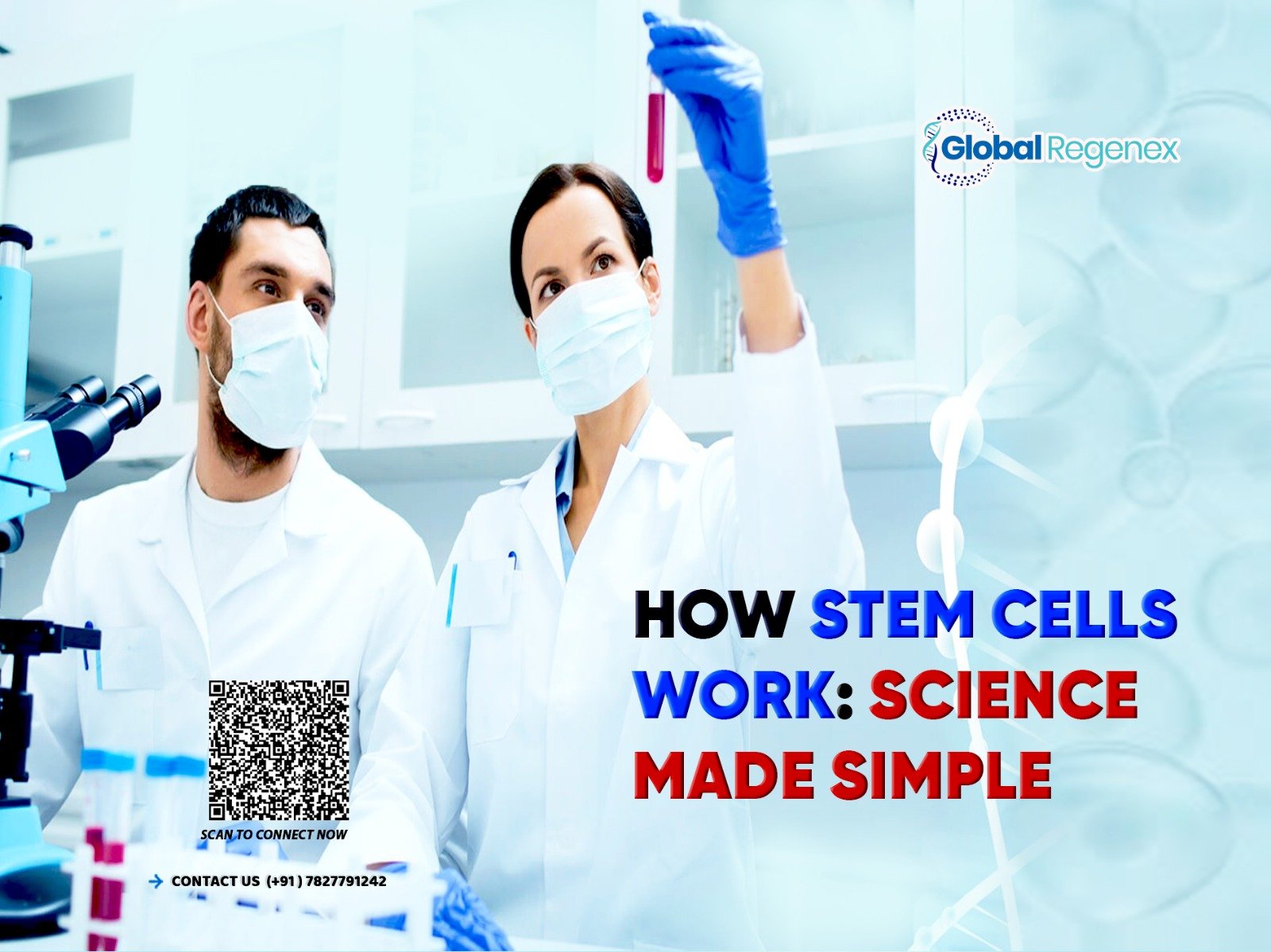Summary: Stem cells are the body’s own repair system with the special power to self-renew and differentiate into specialized cells. They are responsible for growth, healing, and medical research. Located in such sites as bone marrow or induced as iPSCs, stem cells are the focus of regenerative medicine, holding promise for the treatment of severe disease and injury.
How Stem Cells Work: Science Made Simple
Millions of people around the world, one way or another, are dealing with some type of severe injury or condition. This makes it natural for them to look for more advanced treatment or therapy to overcome the condition. Fortunately, the treatment lies within the body itself, known as stem cells. In simple words, stem cells are the body’s tiny cells that can grow into different types of cells, such as muscle cells and more.
To gain a deeper understanding of this topic and learn how stem cells function, continue reading the blog as we explore the world of regenerative medicine together. Additionally, if you are interested in stem cell treatment in India, consulting with Global Regenex for excellent guidance is a must.
What Are Stem Cells?
Stem cells are the building blocks of the body, which form more than 200 cells of the body, as they have the ability to differentiate into various types of cells, which also aid in replacing and repairing damaged cells. Unlike regular cells, which can only do a single task, stem cells can generate more stem cells or transform themselves into new cells when necessary.
Key Points About Stem Cells:
- Self-Renewal: They always differentiate themselves again and again, as per the body’s need.
- Flexibility: They are versatile and can change into many types of cells, like blood, muscle, etc.
- Use in Medicine: Stem cells are currently being researched and studied for their medical applications. Doctors study them to treat diseases like diabetes, heart problems, and spinal injuries.
Types of Stem Cells
- Adult Stem Cells are located in locations such as bone marrow and typically develop into some types of cells.
- Induced Pluripotent Stem Cells (iPSCs) are ordinary adult cells modified to behave like embryonic stem cells.
How Do Stem Cells Function?
They are considered special due to the ability to both replicate themselves and transform into other forms of cells that the body requires. Let’s see how they differ from regular cells, which can only do one specific task.
How stem cells operate can be described in two general steps:
- Stem cells can easily divide repeatedly to generate more stem cells of the same type. This guarantees a sufficient supply is always present for growth and repair.
- Stem cells may become specific cells like blood cells, skin cells, muscle cells, or nerve cells based on signals from the body.
For example, to understand this further, suppose you have a cut in your hand, stem cells in the skin will repair and replace the damaged cells and heal the wound. And to talk about the brain and spinal cord, in some cases, stem cells can even repair damage to nerves.
Seeing the potential of stem cells, researchers are examining stem cells for the treatment of diseases like diabetes, heart disease, and spinal cord injury, to repair damaged tissues and improve healing in the area.
Why Are Stem Cells Important?
They are unlike other cells that become specialized to do one thing. Stem cells can replicate into additional stem cells or specialize into various cells, such as blood, nerve, or muscle cells. That is why they are significant in development, in healing, and in research.
Significant reasons stem cells are significant:
Growth and Development
- During infancy, stem cells develop all the tissues and organs of a developing infant.
- They remain active throughout life by contributing to normal development and repairing damaged or worn-out cells.
Healing and Repair
- Stem cells in bone marrow continuously produce new blood cells that maintain the immune system.
- They repair wounds, damaged tissue, and even some organs by creating new, healthy cells.
Medical Research
- Scientists research stem cells in an attempt to understand how disease occurs at the cellular level.
- They can be tested on with new medication and treatments without any danger.
Regenerative Medicine
- Stem cells have the potential to repair or replace damaged tissues and organs.
- They also hold hope for curing diseases such as diabetes, heart disease, spinal cord injury, Parkinson’s disease, and certain types of blindness.
- They can minimize organ donor requirements by growing tissues in the laboratory.
Putting It All Together
Stem cells are so much more than small microscopic blocks; they are the future wave for renewal and creativity in medicine today. Repair, renewal, and regeneration through the assistance of stem cells are vital to the health of humankind and the advancement of science. And with additional research and treatment alternatives, stem cells bring a possibility of revolutionizing the way we treat disease and grow life back.
Frequently Asked Questions (FAQs)
Q.1 Can I Increase My Number of Stem Cells Naturally?
Ans. Yes, you can also maintain stem cell health naturally by exercising regularly, getting good sleep, eating balanced food, fasting, and managing stress.
Q2. How do Stem Cells Work Simply?
Ans. Stem cells function by producing more stem cells and transforming into other types of cells, enabling the body to develop, repair, and recover.
Q3. How Can I Keep My Stem Cells Healthy?
Ans. You can maintain your stem cells in a healthy condition by exercising, having a balanced diet, sleeping comfortably, avoiding stress, and not smoking or drinking too much alcohol.
Q4. Where Do Stem Cells Live in the Body?
Ans. Stem cells reside in most regions of your body, especially in bone marrow, blood, brain, skin, muscles, and fat tissue.

